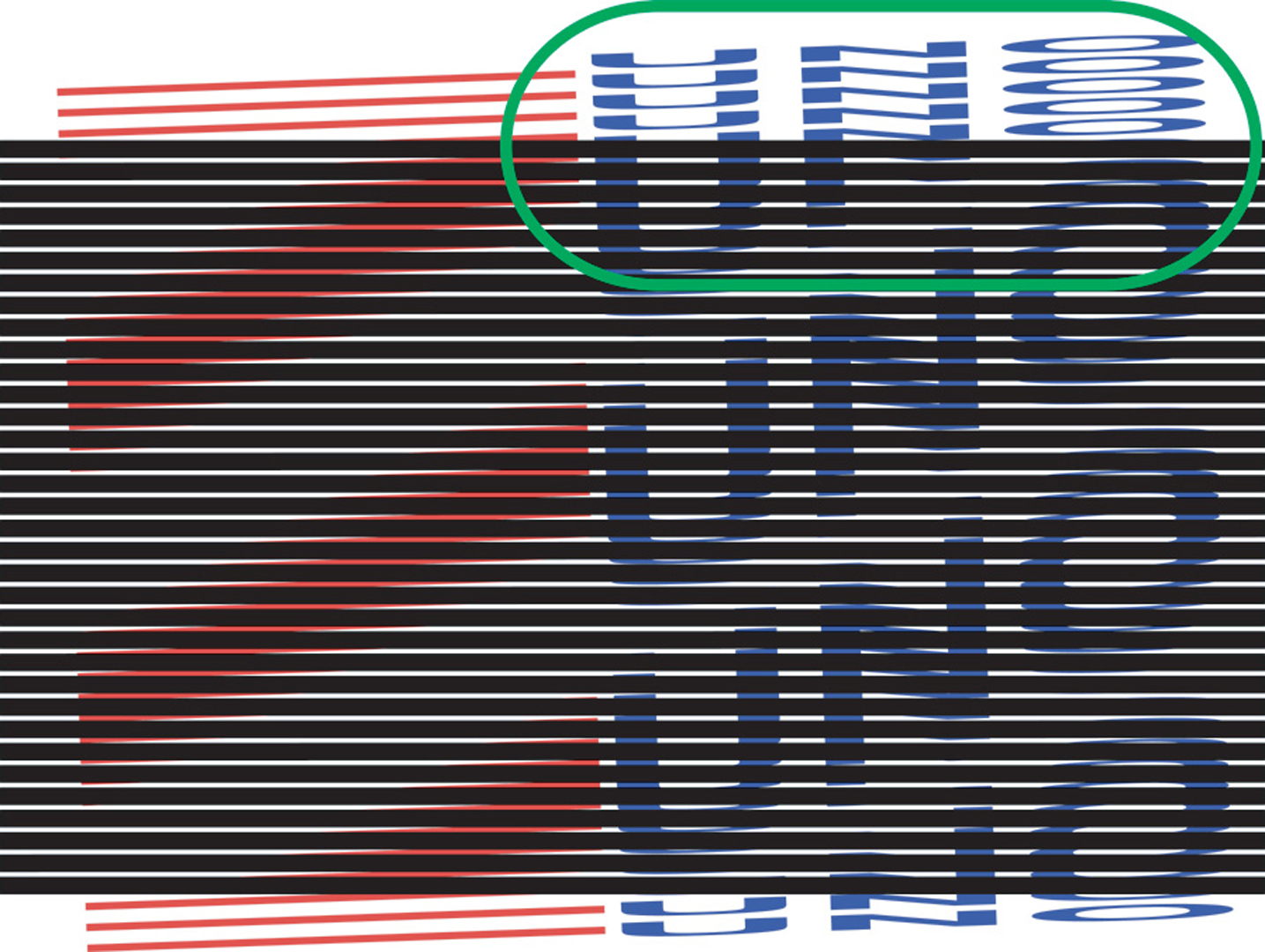“Band moiré images” by Chosson and Hersch
Conference:
Type(s):
Title:
- Band moiré images
Presenter(s)/Author(s):
Abstract:
We propose a new powerful way of synthesizing moiré images that enables the creation of dynamically moving messages incorporating text, symbols, and color elements. Moiré images appear when superposing a base layer made of replicated base bands and a revealing layer made of a line grating comprising thin transparent lines. Each replicated base band contains the same image, e.g. text or color motifs. Since the base bands and the revealing line grating have similar periods, the revealed moiré image is the image located within each base band, enlarged along one dimension. By considering the formation of the moiré image as a line sampling process, we derive the linear transformation between the base layer and the moiré image. We obtain the geometric layout of the resulting moiré image, i.e. its orientation, size and displacement direction when moving the revealing layer on top of the base layer. Interesting moiré images can be synthesized by applying geometric transformations to both the base and the revealing layers. We propose a mathematical model describing the geometric transformation that a moiré image undergoes, when its base layer and its revealing layer are subject to different freely chosen non-linear geometric transformations. By knowing in advance the layout of a moiré image as a function of the layouts of the base layer and of the revealing layer, we are able to create moiré components running up and down at different speeds and orientations upon translation of the revealing layer. We also derive layer transformations which yield periodic moiré images despite the fact that both the base and the revealing layers are curved. By offering a new means of artistic expression, band moiré images can be used to create new designs and to synthesize visually appealing applications.
References:
1. AMIDROR, I. 2000. The Theory of the Moiré Phenomenon, Kluwer, 2000Google ScholarCross Ref
2. AMIDROR, I. 1994. A generalized Fourier-based method for the analysis of 2D moiré envelope forms in screen superpositions, Journal of Modern Optics, Vol. 41, No. 9, 1837–1862Google ScholarCross Ref
3. AMIDROR, I. 1997. Fourier spectrum of radially periodic images, Journal of the Optical Society of America A, Vol. 14, No. 4, April 1997, 816–826.Google ScholarCross Ref
4. AMIDROR, I. 1998. The Fourier-spectrum of circular sine and cosine gratings with arbitrary radial phases, Optics Comm., Vol. 149, 127–134Google ScholarCross Ref
5. AMIDROR, I. 2002. A new print-based security strategy for the protection of valuable documents and products using moiré intensity profiles, Optical Security and Counterfeit Deterrence Technique IV, Rudolf L. van Renesse, Editor, Proc. SPIE Vol. 4677, 2002, 89–100Google Scholar
6. BRACEWELL, R. N. 1986. The Fourier Transform and its Applications, McGraw-HillGoogle Scholar
7. BRYNGDAHL, O. 1974. Moiré: Formation and interpretation, Journal of the Optical Society of America, Vol. 64, No. 10, 1287–1294.Google ScholarCross Ref
8. DURELLI, A. J., PARKS, V. J. 1970. Moiré Analysis of Strain. Prentice-HallGoogle Scholar
9. HUCK J. 2003, Mastering Moirés. Investigating Some of the Fascinating Properties of Interference Patterns, http://pages.sbcglobal.net/joehuckGoogle Scholar
10. HUTLEY, M. C., HUNT, R., STEVENS, R. F. AND SAVANDER, P. 1994. The Moiré Magnifier, Pure and Applied Optics, Vol. 3, 133–142Google ScholarCross Ref
11. LEVANON, G. AND BRUCKSTEIN, A. M. 2001. Variational approach to moiré pattern synthesis, JOSA A, Vol. 18, No. 6, June 2001, 1371–1382.Google Scholar
12. MCGREW, 1995. Anticounterfeiting method and device utilizing holograms and pseudorandom dot patterns, US patent No. 5,396,559, 1995Google Scholar
13. MIKAMI, O. 1975. New Image Rotation Using Moiré Lenses, Japan Journal of Applied Physics, Vol. 14, No. 7, 1065–1066Google ScholarCross Ref
14. NISHIJIMA, Y. AND OSTER, G. 1964. Moiré Patterns: Their Application to Refractive Index and Refractive Index Gradient Measurements, Journal of the Optical Society of America, Vol. 54, No. 1, 1–5Google ScholarCross Ref
15. OSTER, G., WASSERMAN, M., ZWERLING, C. 1964. Theoretical Interpretation of Moiré Patterns. Journal of the Optical Society of America, Vol. 54, No. 2, 169–175Google ScholarCross Ref
16. OSTER G. 1965. Optical Art, Applied Optics, Vol. 4, No. 11, 1359–1369Google ScholarCross Ref
17. POST, D. 1967. Sharpening and Multiplication of Moiré Fringes, Experimental Mechanics, Vol. 7, April 1967, 154–159Google Scholar
18. POST, D., HAN, B., IFJU, P. 1994. High-Sensitivity Moiré: Experimental Analysis for Mechanics and Materials. Springer VerlagGoogle Scholar
19. RIGHI, A. 1887, Sui fenomeni che si producono colla sovrappposizione di due reticoli e sopra alcune loro applicazioni, Nuovo Cimento Vol. 21, 203–228 (1887) and Vol. 22, 10–34 (1888)Google ScholarCross Ref
20. TAKASAKI, H. 1970. Moiré Topography, Applied Optics, Vol. 9, No. 6, 1467–1472Google ScholarCross Ref
21. TOLLENAAR, D. 1945. Moiré-Interferentieverschijnselen bij rasterdruk, Amsterdam Instituut voor Grafische Technick, Moiré in halftone printing interference phenomena, published in 1964, reprinted in Indebetouw G. Czarnek R. (Eds.). Selected Papers on Optical Moiré and Applications, SPIE Milestone Series, Vol. MS64, SPIE Press, 1992, 618–633Google Scholar
22. YULE, J. A. C. 1967. Principles of Color Reproduction, Wiley, 1967, Chap13Google Scholar




